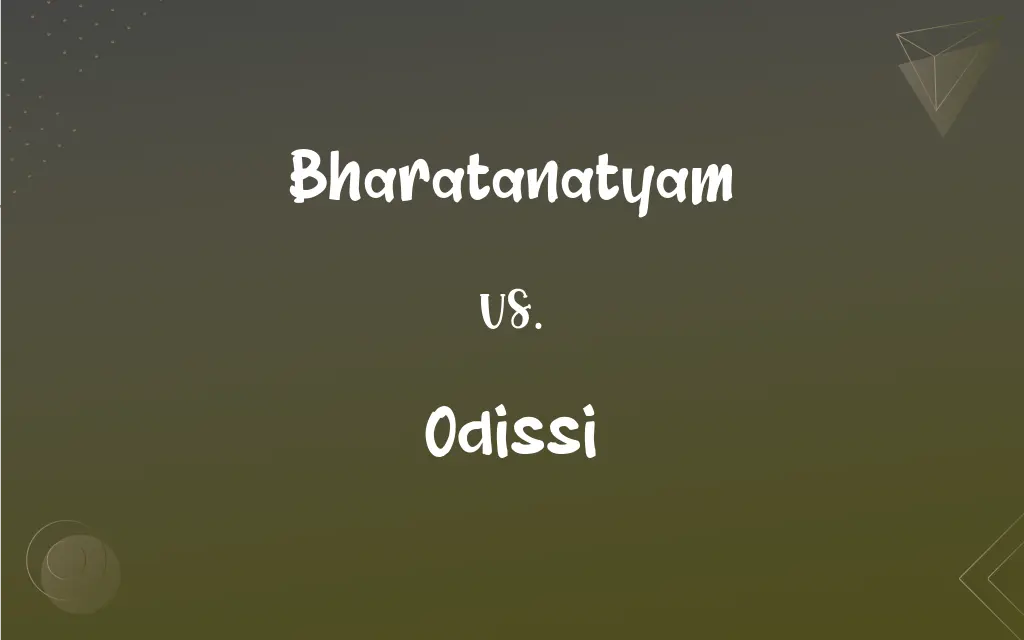Bharatanatyam vs. Odissi: What's the Difference?
Edited by Aimie Carlson || By Janet White || Published on February 27, 2024
Bharatanatyam is a classical dance from Tamil Nadu, known for its grace and sculpturesque poses, while Odissi, from Odisha, is characterized by fluid movements and expressive gestures.

Key Differences
Bharatanatyam is a classical Indian dance form from Tamil Nadu, known for its geometric and balanced movements. Odissi, originating from Odisha, is distinguished by its fluid, graceful movements and tribhangi posture (three-body bend).
In Bharatanatyam, the emphasis is on strong footwork, straight lines, and precise, sharp movements. Odissi dance is characterized by its soft, lyrical, and flowing movements, with a greater emphasis on the upper body movements and facial expressions.
The costumes in Bharatanatyam are typically brightly colored sarees with gold borders, accompanied by heavy jewelry, and the hair is tied in a bun adorned with flowers. Odissi dancers wear silver jewelry and silk sarees woven with intricate designs, with hair often styled in elaborate ways.
Bharatanatyam performances are known for their emphasis on nritta (pure dance), nritya (expressive dance), and natya (dramatic aspect), conveying religious themes and spiritual ideas. Odissi is deeply rooted in devotion and often portrays stories and themes from Hindu mythology, especially of Lord Jagannath and Radha-Krishna.
The music in Bharatanatyam is predominantly Carnatic, featuring instruments like the mridangam and violin. Odissi music is softer and lyrical, utilizing instruments such as the pakhawaj, flute, and sitar.
ADVERTISEMENT
Comparison Chart
Origin
Tamil Nadu, South India
Odisha, East India
Movement Style
Geometric, balanced, strong footwork
Fluid, graceful, tribhangi posture
Costume
Bright sarees, gold borders, heavy jewelry
Silk sarees, intricate designs, silver jewelry
Dance Aspects
Nritta, Nritya, Natya
Expressive, devotion-oriented
Music
Carnatic with mridangam, violin
Softer, lyrical with pakhawaj, flute, sitar
ADVERTISEMENT
Bharatanatyam and Odissi Definitions
Bharatanatyam
Bharatanatyam is a classical Indian dance form known for its precision and grace.
She performed a Bharatanatyam piece that captivated the audience with its perfection.
Odissi
Odissi is distinguished by its elaborate costumes and intricate jewelry.
The Odissi dancers were adorned in beautiful silk sarees and elaborate silver jewelry.
Bharatanatyam
Bharatanatyam originated in temples as a form of spiritual expression.
Bharatanatyam was traditionally performed in temples as a devotional offering to the deities.
Odissi
Odissi is an Indian classical dance characterized by fluid movements and expressive grace.
Her Odissi performance was a mesmerizing display of fluidity and elegance.
Bharatanatyam
Bharatanatyam is characterized by its rhythmic footwork and sculpturesque poses.
The Bharatanatyam dancer's footwork was impeccably timed to the music.
Odissi
Odissi dance is known for its unique tribhangi posture and lyrical movements.
The dancer's tribhangi pose in the Odissi performance was strikingly beautiful.
Bharatanatyam
Bharatanatyam combines pure dance, expressive gestures, and storytelling.
His Bharatanatyam recital beautifully narrated an ancient mythological tale.
Odissi
Odissi often portrays stories from Hindu mythology with expressive gestures and facial expressions.
In the Odissi recital, she depicted a story of Radha and Krishna with great emotion.
Bharatanatyam
Bharatanatyam uses a combination of hand gestures and facial expressions to convey emotions.
Through her expressive Bharatanatyam performance, she conveyed a range of emotions.
Odissi
Odissi dance integrates spiritual themes with technical and rhythmic precision.
The precision and spirituality in her Odissi dance left the audience in awe.
FAQs
What kind of music accompanies Bharatanatyam?
Bharatanatyam is typically accompanied by Carnatic music, featuring instruments like the mridangam and violin.
How old is the Bharatanatyam tradition?
Bharatanatyam has ancient roots, with evidence dating back to 2nd century CE and earlier in Tamil Nadu.
What is the origin of Odissi dance?
Odissi originated in the temples of Odisha as a form of worship and has evolved over centuries.
What is the significance of the tribhangi posture in Odissi?
The tribhangi, or three-body bend, is a signature posture in Odissi that symbolizes beauty and grace, dividing the body into three parts.
Are the costumes for Bharatanatyam and Odissi different?
Yes, Bharatanatyam costumes are bright sarees with gold borders, while Odissi costumes are silk sarees with silver jewelry.
Can Bharatanatyam tell a story?
Yes, Bharatanatyam combines dance, mime, and music to narrate stories, especially from Hindu mythology.
What is Bharatanatyam?
Bharatanatyam is a classical dance form from Tamil Nadu, India, known for its precise and elegant movements.
What is Odissi?
Odissi is a classical dance form from Odisha, India, characterized by its fluidity, expressiveness, and tribhangi posture.
Is Odissi dance linked to any religious practices?
Historically, Odissi was performed in temples as a sacred ritual and is deeply rooted in Hindu spirituality.
How does costume enhance the performance of Odissi?
The elaborate costumes in Odissi, including the intricate jewelry and makeup, enhance the visual appeal and help in portraying characters.
What kind of music is used in Odissi dance?
Odissi dance uses softer, lyrical music, often with instruments like the pakhawaj, flute, and sitar.
Is Odissi a solo or group dance?
Odissi can be performed both solo and in groups, with each format offering a unique experience.
How does Odissi emphasize expressiveness?
Odissi emphasizes expressiveness through fluid movements, detailed facial expressions, and hand gestures that convey emotions and stories.
Can Bharatanatyam be performed by both men and women?
Yes, Bharatanatyam is performed by both men and women, each bringing their own dynamism to the dance.
What are the key elements of Bharatanatyam?
Key elements include nritta (pure dance), nritya (expressive dance), and natya (dramatic aspect), along with precise footwork and hand gestures.
Do Bharatanatyam and Odissi require similar training?
Both require rigorous training, but the techniques and styles specific to each form are distinct.
Are there any specific themes common in Bharatanatyam performances?
Bharatanatyam often portrays Hindu religious themes, spiritual ideas, and mythological stories.
What makes Odissi distinct from other Indian classical dances?
Odissi is distinct for its lyrical movements, expressive grace, tribhangi posture, and its close association with temple dance traditions.
How has Bharatanatyam evolved over the years?
While retaining its traditional roots, Bharatanatyam has evolved with new choreographies and interpretations, making it relevant to contemporary audiences.
What is the importance of hand gestures in Bharatanatyam?
Hand gestures, or mudras, in Bharatanatyam are crucial for storytelling and expressing emotions.
About Author
Written by
Janet WhiteJanet White has been an esteemed writer and blogger for Difference Wiki. Holding a Master's degree in Science and Medical Journalism from the prestigious Boston University, she has consistently demonstrated her expertise and passion for her field. When she's not immersed in her work, Janet relishes her time exercising, delving into a good book, and cherishing moments with friends and family.
Edited by
Aimie CarlsonAimie Carlson, holding a master's degree in English literature, is a fervent English language enthusiast. She lends her writing talents to Difference Wiki, a prominent website that specializes in comparisons, offering readers insightful analyses that both captivate and inform.































































